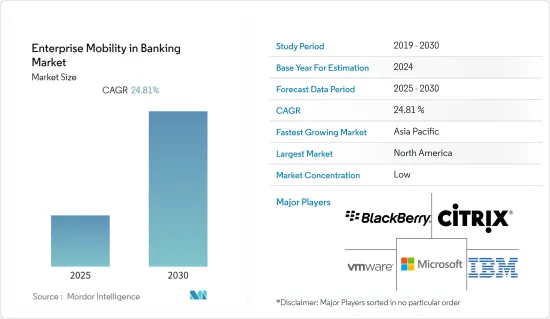Need help finding what you are looking for?
Contact Us
PUBLISHER: Mordor Intelligence | PRODUCT CODE: 1628794

PUBLISHER: Mordor Intelligence | PRODUCT CODE: 1628794
Enterprise Mobility in Banking - Market Share Analysis, Industry Trends & Statistics, Growth Forecasts (2025 - 2030)
PUBLISHED:
PAGES: 120 Pages
DELIVERY TIME: 2-3 business days
SELECT AN OPTION
The Enterprise Mobility in Banking Market is expected to register a CAGR of 24.81% during the forecast period.

Key Highlights
- Mobile devices are almost ubiquitous and are displaying similar trends across enterprises. Thus, deploying appropriate controls in companies is expected to benefit them from mobility opportunities while ensuring that sensitive data and devices are safeguarded. For instance, an EMM policy ensures that the enterprise's application, content, and device are fully integrated and safe to use, including secure access mechanisms.
- The banks and allies are pivoting to allow BYOD and require EMM for secure data and regulatory compliance for their financial exchanges. With the proliferation of multiple OS, like macOS, Windows 10, and ruggedized devices, along with the Internet of Things (IoT), the mobile hardware context enlarges, enabling enterprises to focus on EMM.
- Further, the banking industry needs a proper system to manage the overall inventory of devices and track whether the devices are online or offline. Banks primarily need to keep track of all their mobile devices used in the field by the salesforce and ensure that the employees are using them effectively. Any unintended use of the devices, such as watching non-related videos, playing games, or installing any app, can lead to a loss of productivity.
- Additionally, the coronavirus outbreak caused an unpredictable worldwide situation for most businesses. Banks needed to enable their employees to operate remotely in the banking industry immediately. The rising need for digital infrastructure to facilitate the continuation of uninterrupted services is expected to create a demand for mobility solutions in the industry.
- However, one of the critical challenges and barriers to entry for mobilization is the high cost. Even with BYOD solutions, the budget still has to cover integration, development, telecom, and many others. Also, integrating new mobile apps and technologies into the existing infrastructure can be expensive and time-consuming.
Banking Enterprise Mobility Market Trends
Increase in Cyber Attacks to Drive Market Growth
- Data breaches lead to an exponential cost rise and the loss of valuable customer information. According to the X-Force Threat Intelligence Index of last year, 22.4% of attacks that X-Force addressed targeted financial and insurance businesses, out of which 70% of attacks were on banks. Thus, financial and insurance businesses were second in X-Force's industry rankings in the previous year. In pursuit of the most straightforward path possible to financial gain, cyber attackers attack the financial services industry.
- Moreover, according to the latest edition of Cisco's annual Security Outcomes Report launched in December 2022, cybersecurity resilience is a foremost priority for companies as they look to protect against a rapidly growing threat landscape as 62 percent of organizations surveyed stated they had experienced a security event that impacted business in the past two years.
North America to Witness Significant Growth
Banking Enterprise Mobility Industry Overview
Additional Benefits:
Product Code: 54401
TABLE OF CONTENTS
1 INTRODUCTION
- 1.1 Study Assumptions and Market Definition
- 1.2 Scope of the Study
2 RESEARCH METHODOLOGY
3 EXECUTIVE SUMMARY
4 MARKET INSIGHT
- 4.1 Market Overview
- 4.2 Industry Attractiveness - Porter's Five Forces Analysis
- 4.2.1 Bargaining Power of Suppliers
- 4.2.2 Bargaining Power of Consumers
5 MARKET SEGMENTATION
6 COMPETITIVE LANDSCAPE
7 VENDOR MARKET SHARE ANALYSIS
8 INVESTMENT ANALYSIS
9 FUTURE OF THE MARKET
Have a question?


SELECT AN OPTION
Have a question?


Questions? Please give us a call or visit the contact form.
